Best GTX 1080 Ti Graphics Card – Buyer’s Guide
(Interactive GTX 1080 Ti comparison chart found above! Please give it a few seconds to load..)
“Pascal” is one of those terms that will go down in GPU history as a great milestone – it will be remembered as the moments NVIDIA managed to break its own records and release a family of graphics cards that wrote history. Whether we’re talking about the high-end segment, which used to be dominated by the GTX 1080, the mid-range segmented ruled by the GTX 1070 and 1060, or the low-end segment covered by the equally impressive GTX 1050 and GTX 1050 Ti, the Pascal architecture showed its strength each and every time, providing unparalleled power. We won’t even go into the professional segment, where behemoths such as the Quadro and the Titan push Pascal to its limits with astronomical numbers.
And just when we thought we saw everything Pascal had to offer, there comes the GTX 1080 Ti. To be completely fair, the GTX 1080 Ti’s release was not a complete surprise, as NVIDIA did show a tendency to launch a Ti version of its top-of-the-line consumer cards in the past, and use it to minimize the gap between the consumer and professional segments. To achieve this, NVIDIA opted to go with a slightly scaled-down version of the GP102 GPU found in the Pascal GTX Titan, rather than the GP104 GPU used by the GTX 1080. As a result, the specs of the NVIDIA GTX 1080 Ti are remarkable, to say the least: 3584 CUDA cores, 224 texture units, a whopping 11GB of GDDR5X memory with a speed of 11GHz and a bandwidth of 484GB/s, and a TDP of 250W. The best part is that these are the reference values; as usual, manufacturers go with custom implementations that allow them to push the figures even further. Let’s see who did it the best – here’s a roundup of the best GTX 1080 Ti implementations out there.
Best GTX 1080 Ti Aftermarket Card – Asus ROG Strix GTX 1080 Ti Gaming OC
No products found.No products found.
GTX 1080 Tis come in all shapes and sizes, each designed to excel in one specific segment, be it overclocking, staying silent or just looking pretty. Asus’ ROG Strix GeForce GTX 1080 Ti OC is the card that ticks all those boxes, providing the perfect mix between performance and aesthetics. It comes with a base clock of 1569MHz, which goes up to 1683MHz in Gaming Mode and 1708MHz in automatic OC mode. However, the massive cooling system the card comes with should allow you to push it even further without much trouble. Said cooling system will not only keep the card cool under any circumstances, but it will also stay quiet while doing so, thanks to its 3 huge vents that can come to a complete standstill when the card is not under load, thus becoming dead-silent. Pushing things even further in the cooling department is the Asus FanConnect II feature, which allows you to connect 2 case fans directly to the card, and control their speed based on GPU temperature.
Being part of the ROG family, the Asus GTX 1080 Ti also comes with bragging rights in the looks department. The cooling system is the main element that gives the card its imposing feel, but the large backplate that spreads across its back and the RGB-illuminated logos on the backplate and side of the card also contribute to the picture.
With a price tag in the ballpark of $800, the Asus ROG GTX 1080 Ti OC is not the cheapest implementation out there, but it does provide exceptional value for its money considering all the features it packs and Asus’ renowned quality, so if you’re looking for the best overall GTX 1080 Ti, you just found it.
Best GTX 1080 Ti for Overclocking – Gigabyte Aorus GTX 1080 Ti Xtreme Edition

When it comes to performance, the GTX 1080 Ti is a monster of a video card, crushing pretty much any other GPU out there and pushing games to their max settings without much effort. Be that as it may, some people want more, and for those who do, Gigabyte delivers more in the shape of the Gigabyte Aorus GTX 1080 Ti Xtreme Edition.
Right from the first glance, you can easily tell that the Aorus GTX 1080 Ti Xtreme Edition was specifically designed to dominate: the card is huge, spanning across 3 slots, and that’s due to its gargantuan cooling system. Its three 100mm fans along with the cooper plate that covers its GPU and VRM areas on the back of the card are solid indicators that the card is ready to take some beefy overclocking, but it’s only when you look at the specs that you get to actually understand just how far the card can go. The card comes with two 8-pin power connectors and a 150% increase in the power allowance, which means the card can reach a TDP of up to 375W. A 12+2 power phase design also contributes to the overclocking potential of the card. That translates into a tremendous overclocking potential, as demonstrated by the guys at guru3d.com, who managed to overclock the Gigabyte Aorus GTX 1080 Ti Xtreme Edition to some staggering limits: 1647MHz core clock (vs. the stock 1607MHz), 2038MHz Boost clock (vs. 1721MHz stock) and a memory clock of 12246MHz (vs. 11232MHz stock). As you can imagine, those numbers translate into a noticeable performance gain, so if you’re looking to squeeze the most out of a GTX 1080 Ti, the Gigabyte Aorus GTX 1080 Ti Xtreme Edition is the card to do so with.
Best GTX 1080 Ti for Silent Operation – EVGA GTX 1080 Ti SC2
In the past, the roar of a PC’s hardware was directly proportional with its performance – the louder it was, the more computational horsepower it was likely to hide under the hood. While some of today’s hardware can still get pretty loud at times as well, it is no longer an accurate indicator of performance, and the EVGA GTX 1080 Ti SC2 is the perfect example as to why: the card delivers the performance of a GTX 1080 Ti, minus the hums and whirs.
The EVGA GTX 1080 Ti SC2 features clock speeds that put it in the mid-range of the 1080 Ti lineup – it is still faster than a reference model, but it lags behind other 1080 Ti models like the ROG or the Aorus. Out of the box, the SC2 comes with a 1556MHz base clock and a boost frequency of 1670MHz. Its memory runs at 11016MHz.
Sure enough, the EVGA GTX 1080 Ti SC2’s standout feature is its iCX cooling system which consists of a combination of elements: 9 thermal sensors which allow for an unprecedented monitoring of temperatures throughout key points of the card, redesigned airflow chambers, baseplate and backplate for the most efficient heat dissipation and, last but not least, independently-controlled vents. Unlike other cards, which just turn off the coolers when the card is not under load, the EVGA GTX 1080 Ti SC2 can turn them off completely, but also turn them on and adjust their speeds independently, based on data fed by the 9 thermal sensors, which allows for a more precise cooling and more silent operation.
If you want a stealth approach to performance, you want the EVGA GTX 1080 Ti SC2.
Best GTX 1080 Ti for SFF PC/mini-ITX builds – Galax GTX 1080 Ti EXOC
No products found.No products found.
Small form factor builds are becoming more popular nowadays, and they get bonus points when they pack top-of-the-line hardware. If you’re building a SFF PC, and want to cram in the best of the best, the Galaxy GeForce GTX 1080 Ti EXOC is your card of choice. With a length of 281mm and a dual-slot design, the Galaxy GTX 1080 Ti EXOC should fit in most SFF cases that are designed to house a dual-slot GPU.EXOC’s cooling system consists of a decently-sized cooling block paired with a backplate, and two 90mm vents designed for high heat dissipation and low noise. The vents also feature the full-stop mode when the card is not under load and temperatures are below a certain threshold.Just because it is smaller than other GTX 1080 Ti variants doesn’t mean the Galaxy GTX 1080 Ti lacks in muscle; in fact, it is quite fast, with a base clock of 1531MHz and a boost clock of 1645MHz. Depending on the case you put it in, you might also be able to overclock it to some better figures, but don’t expect any record-shattering values since the card uses the reference PCB design. On the upside, the reference design ensures the card runs stable and provides solid performance out of the box.
Best Value GTX 1080 Ti – MSI GTX 1080 Ti ARMOR 11G OC

MSI is one of the top names in the hardware industry, so it is no surprise that one of its implementations of the GTX 1080 Ti GPU, namely the MSI GTX 1080 Ti ARMOR OC, provides the best value out there.
For a price tag that’s only slightly above the price of a reference board, MSI delivers a custom PCB with Military Class 4 components and its renowned Armor 2X Thermal Design cooling system. The combination is a winning one, as the MSI ARMOR comes with some decent clocks (1531MHz base / 1645MHz Boost), but since MSI cards are known to be good overclockers, those figures are bound to go higher with some times and tweaks, all while remaining cool and quiet due to its gigantic fans.
One thing to keep in mind if you opt for the MSI GTX 1080 Ti ARMOR is its size – at 290 x 143 x 40 mm, the board is significantly wider than most cards out there, so make sure your case can fit it. That aspect aside, the MSI 1080 Ti is a great pick for those that want a custom design and the raw power of a GTX 1080 Ti, but don’t want to pay extra for bling and miscellaneous features.
Best Looking GTX 1080 Ti – ZOTAC GTX 1080 Ti AMP Extreme

They say the beauty is in the eye of the beholder, so aesthetics are always subjective. Be that as it may, we feel that the ZOTAC GTX 1080 Ti AMP Extreme is the best reflection of what a GTX 1080 Ti should look like.
For starters, with a length of 325mm, the AMP Extreme is quite possibly the biggest version of GTX 1080 Ti out there (significantly larger than the 298 mm ROG variant or the 293mm Aorus variant). Its 2.5 slot design and 3 large fans add to its colossal feel. Its color scheme is a little unconventional, and consists of a mostly black enclosure, with some yellow accents on the underside and the logo on top of its backplate. A cutout in the backplate leaves Zotac’s iconic PowerBoost chips exposed to show-off the fact that the card is ready break some frontiers. Its tank-like aspect and industrial-looking color choice make the Zotac GTX AMP Extreme resemble some piece of heavy-machinery, which is exactly what you want a GTX 1080 Ti to denote – caution, danger and an overall feel of tremendous raw power.
The AMP Extreme doesn’t just feel powerful, it is powerful: the card comes with an already impressive 1645MHz base clock and 1759MHz boost, but its build allows for some hefty overclocking as well.
Overall, if you want an imposing GPU that looks like a tank, performs like a tank, and probably even shares a few common components with a tank, the Zotac GTX 1080 Ti AMP Extreme is it.
GTX 1080 Ti vs. Titan XP Pascal – Battle of the Titans

NVIDIA designed the GTX 1080 Ti with two main things in mind: providing the ultimate GPU experience for the consumer segment, and reducing the gap between consumer and professional segments. What NVIDIA didn’t take into account was just how well-designed their Pascal GPUs were – they have really outdone themselves with these chips this time, and the once-significant gap between the Ti and Titan has now become so small that, despite the fact that the 1080 Ti lacks some ROPs and 1GB of memory compared to the Titan, it makes up for the difference with its higher clocks and higher memory bandwidth, reducing the difference between the two cards to an insignificant one.
A constant from previous generations, though, is the price difference – there is still a massive price difference between the GTX 1080 Ti and the Titan X, and while that might have made some sense in the past, where you were actually getting your money’s worth, it doesn’t apply to the Pascal generation. The GTX 1080 Ti is built on the same GPU architecture as the Titan, and delivers roughly the same performance as the Titan, and all that at a fraction of the price of the Titan.
Drawing the line, it appears that, ironically, the Titan is not the winner in the battle of the Titans.
Compare GTX 1080 Ti Aftermarket Cards
Roundup of aftermarket GTX 1080 Ti brands
With the GTX 1080 Ti just around the corner for us everyday gamers to finally get our hands on this seriously impressive $699 MSRP graphics card, we have rounded up the top aftermarket GTX 1080 Ti cards you should look out for. If you are considering building your next gaming PC with this 11GB monster card, then this article is just for you.
Nvidia have already shown us their Founders Edition card with a MSRP of $699, although realistically the cards all of us gamers are looking out for are the aftermarket custom cards offered by the likes of EVGA, ASUS, Palit, Zotac, MSI to name a few. If you’re deciding between going for a reference GTX 1080 Ti card or a aftermarket design, we recommend going for the aftermarket option as they often provide better performance, cooling, as well as producing less noise.
Below is our roundup of the top founders editions and aftermarket GTX 1080 Ti cards that will be hitting stores soon.
Asus GTX 1080 Ti Cards
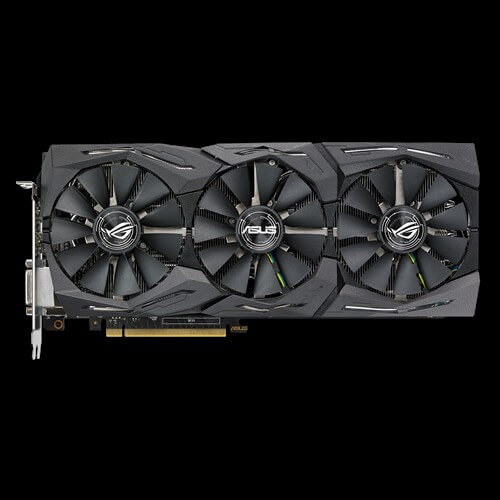
Asus were the first to the aftermarket 1080 Ti scene with their RoG Strix line of cards, including the GTX 1080 Ti Strix, GTX 1080 Ti Gaming OC that feature their characteristic DirectCU III cooler with a triple cooling fan setup and included backplate. Asus will also be providing its Turbo range for the GTX 1080 Ti that is cooled by a standard blower design, and will likely be a bit cheaper than the OC and RoG Strix models and clocks similar to the reference 1080 Ti.
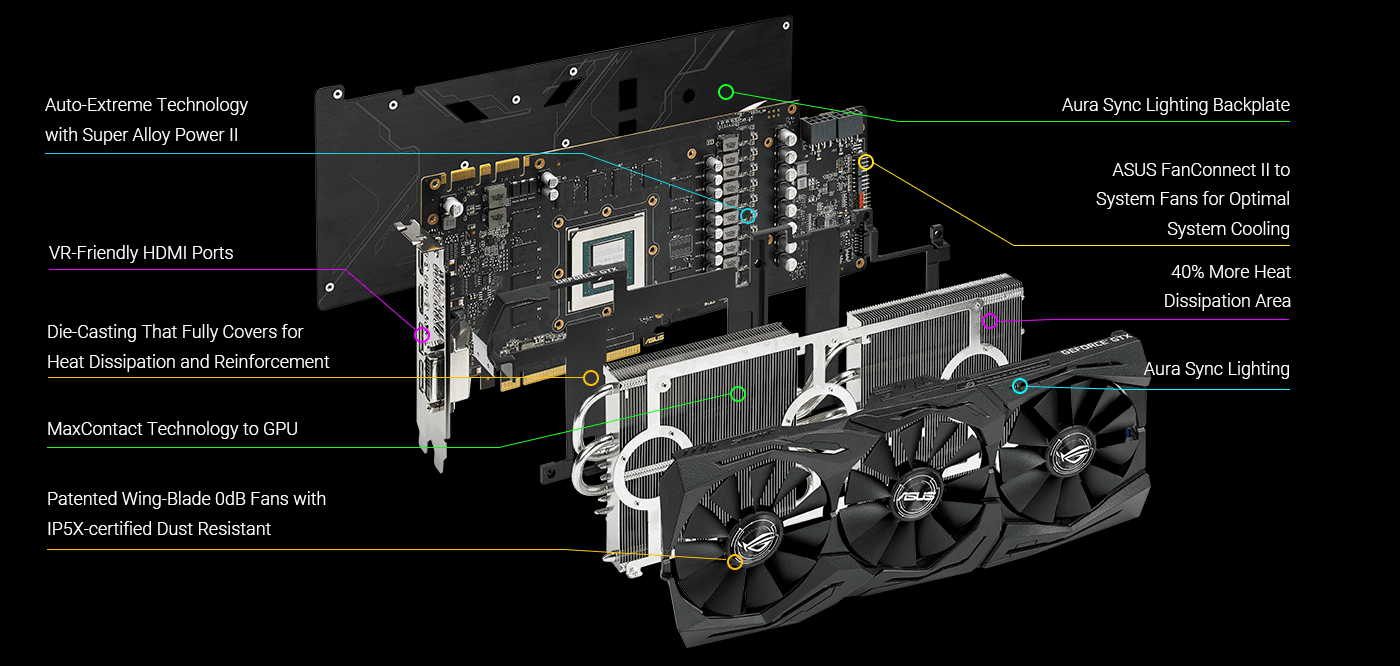
Models:
- Asus GTX 1080 Ti Founders Edition
- Asus GTX 1080 Ti Strix
- Asus GTX 1080 Ti Gaming OC
- Asus GTX 1080 GTX Turbo
Colorful GTX 1080 Ti Cards

Colorful have announced their own founders edition of the 1080 Ti, pictured below, and have recently announced the Colorful iGame GTX 1080 Ti, which features a color LCD screen on the card allowing to likely display temperature stats of the 1080 Ti.
Models:
EVGA GTX 1080 Ti Cards
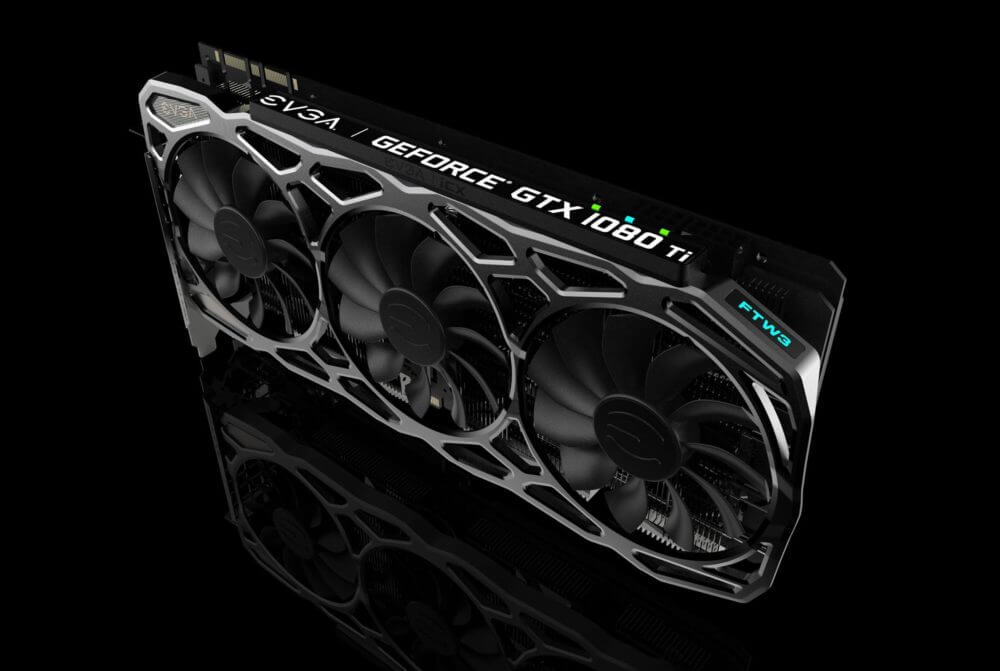
If you’re looking for a solid founders edition card with great warranty, EVGA are the guys to go for. EVGA have announced their founders edition GTX 1080 Ti, as well as their GTX 1080 Ti FTW3 aftermarket card which features a triple 100mm fan cooling design, as well as a number of impressive sensors on the card to help the everyday gamer to keep a close watch on the temperatures of the 1080 Ti.
Models:
- EVGA GTX 1080 Ti Founders Edition
- EVGA GTX 1080 Ti SC Black
- EVGA GTX 1080 Ti SC2
- EVGA GTX 1080 Ti FTW3
Gigabyte GTX 1080 Ti Cards

Gigabyte have two lines currently offering the GTX 1080 Ti card, including their AUROS brand as well as the standard Gigabyte name.
Gainward GTX 1080 Ti Cards
No announcements yet form Gainward on their aftermarket, custom GTX 1080 Ti cards, although they have got a Founders Edition card on the way. Interested to see what they release given their strong track record with their aftermarket GTX 1070 and GTX 1080 variants.
Models:
Inno3D GTX 1080 Ti Cards

Here at GPUnerd we haven’t been the biggest fans of Inno3D aftermarket cards in the past, although this newly announced aftermarket GTX 1080 Ti card by Inno3D does catch our eye. This impressive card features a quad fan cooling setup, with a triple fan setup on the side and an additional fan on the top. Impressive, we can’t wait to see if this actually delivers cooler temperatures and higher overclocks from the 1080 Ti.
Models:
MSI GTX 1080 Ti Cards
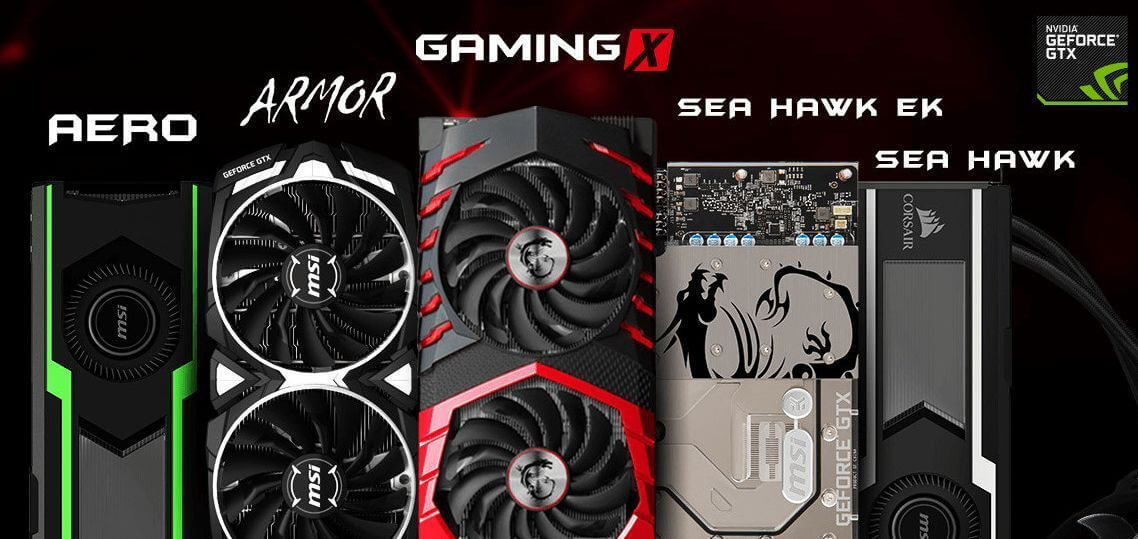
MSI have got a Founders Edition version of the GTX 1080 Ti coming to stores shortly, as well as their aftermarket version of the 1080 Ti, too. The aftermarket MSI 1080 Ti, named the GeForce GTX 1080 Ti Gaming X, features a dual fan ‘Twin Frozr VI’ – whatever that means – as well as the gimmick of RGB to satisfy all those die hard RGB fanboys out there. Looking forward to seeing more 1080 Ti variants coming form MSI in the near future. UPDATE: New models have been announced form MSI, including the Sea Hawk, Sea Hawk, Armor and Aero variants of the GTX 1080 Ti graphics card.
Models:
- MSI GTX 1080 Ti Founders Edition
- MSI GTX 1080 Ti Gaming X
- MSI GTX 1080 Ti Armor OC
- MSI GTX 1080 Ti Aero
- MSI GTX 1080 Ti Sea Hawk
- MSI GTX 1080 Ti Sea Hawk EK
Palit GTX 1060 Ti Cards
No aftermarket cards announced yet from the folks over at Palit, although they have a Founders Edition variant of the GTX 1080 Ti coming soon.
Models:
PNY GTX 1080 Ti Cards
No PNY aftermarket 1080 Ti’s have been announced yet, but they have announced they are doing a Founders Edition GTX 1080 Ti.
Models:
Zotac GTX 1080 Ti Cards
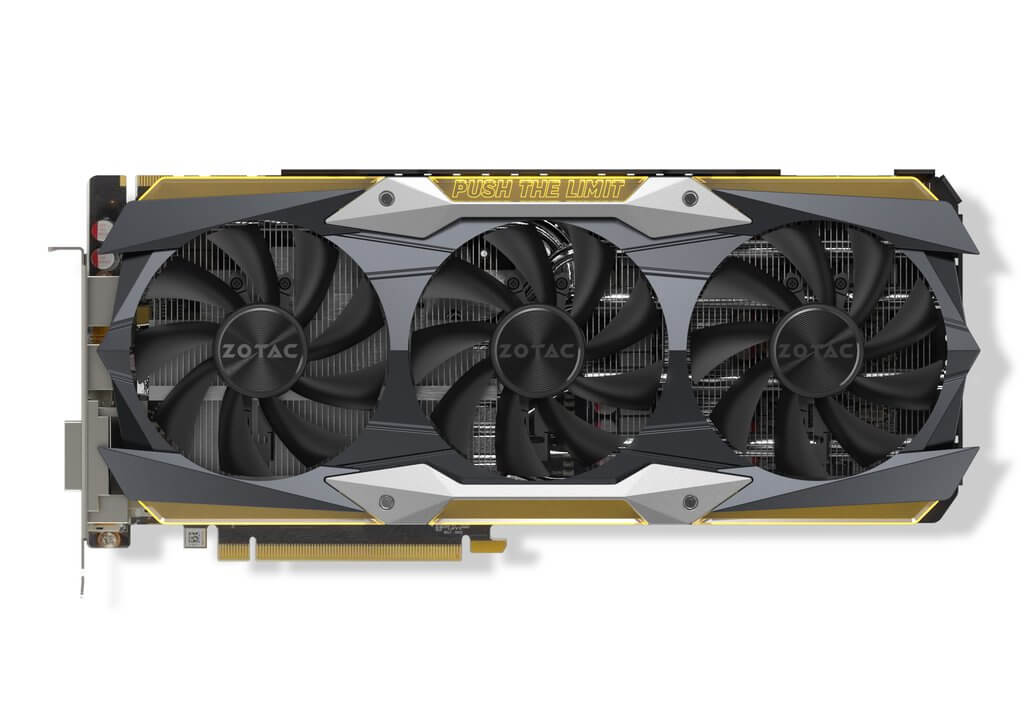
Zotac have initially announced 2 cards to their GTX 1080 Ti card lineup, featuring a Founders Edition coming as well as aftermarket 1080 Ti variant that has a newly designed triple fan cooling setup and finally two 8-pin connectors. Their popular AMP range is back again with the GTX 1080 Ti, with their announced ZOTAC GTX 1080 Ti AMP Extreme model, featuring a triple fan setup, PowerBoost, as well as 16 + 2 power phases. Interested to see how well this card performs against the likes of the EVGA FTW3 aftermarket 1080 Ti.

Models:
- Zotac GTX 1080 Ti Founders Edition
- Zotac GTX 1080 Ti Blower
- Zotac GTX 1080 Ti PGF
- Zotac GTX 1080 Ti AMP Edition
- Zotac GTX 1080 Ti AMP Extreme
There you go, the top GTX 1080 Ti aftermarkets that have been announced so far, and its going to be interesting to see which aftermarket GTX 1080 Ti card performs the best out of them all with the highest overclocks, the best cooling, as well as the best value GTX 1080 Ti. Which one is your favourite aftermarket 1080 Ti that has been announced?
Let us know in the comments below!
[tcb-script src=”//z-na.amazon-adsystem.com/widgets/onejs?MarketPlace=US&adInstanceId=0c999353-e905-439e-a3d1-a35224c04532″][/tcb-script]If you’re in the market for a new card, why not also consider the recently reduced GTX 1080? These cards are still highly powerful, capable and now present great value with their price reduction in light of the GTX 1080 Ti announcement. Here’s our guide on the best aftermarket GTX 1080 brand if you’re interested.









